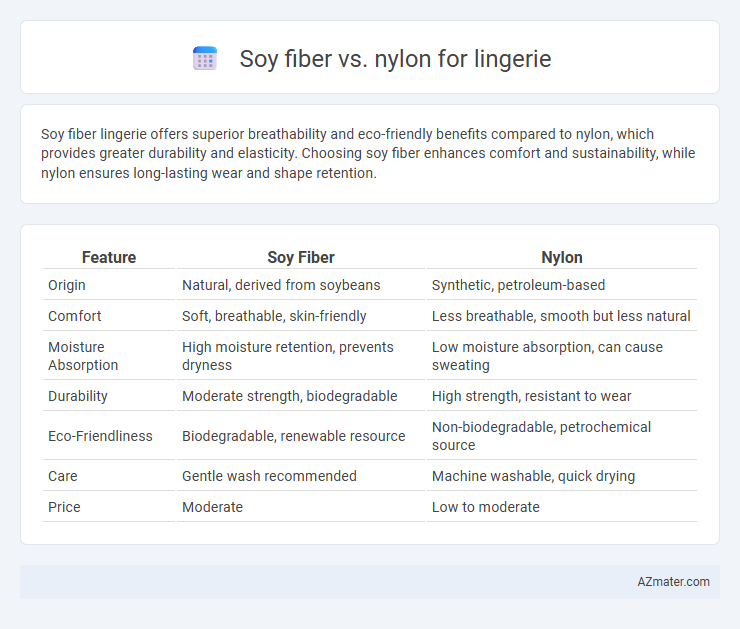Soy fiber lingerie offers superior breathability and eco-friendly benefits compared to nylon, which provides greater durability and elasticity. Choosing soy fiber enhances comfort and sustainability, while nylon ensures long-lasting wear and shape retention.
Table of Comparison
| Feature | Soy Fiber | Nylon |
|---|---|---|
| Origin | Natural, derived from soybeans | Synthetic, petroleum-based |
| Comfort | Soft, breathable, skin-friendly | Less breathable, smooth but less natural |
| Moisture Absorption | High moisture retention, prevents dryness | Low moisture absorption, can cause sweating |
| Durability | Moderate strength, biodegradable | High strength, resistant to wear |
| Eco-Friendliness | Biodegradable, renewable resource | Non-biodegradable, petrochemical source |
| Care | Gentle wash recommended | Machine washable, quick drying |
| Price | Moderate | Low to moderate |
Introduction to Soy Fiber and Nylon in Lingerie
Soy fiber, derived from soybean protein, offers a sustainable and biodegradable option for lingerie, known for its softness, breathability, and moisture-wicking properties that enhance comfort and skin sensitivity. Nylon, a synthetic polymer widely used in lingerie, provides exceptional strength, elasticity, and durability, making it ideal for form-fitting designs and long-lasting wear. The choice between soy fiber and nylon depends on prioritizing natural, eco-friendly materials or durable, elastic performance fabrics in lingerie design.
Environmental Impact: Soy Fiber vs Nylon
Soy fiber is derived from renewable soybean protein sources, making it biodegradable and compostable, which significantly reduces its environmental footprint compared to synthetic fibers. Nylon production relies heavily on petrochemicals, contributing to carbon emissions and non-biodegradability, causing long-term pollution in marine and terrestrial ecosystems. The water consumption and chemical use in soy fiber processing are generally lower than in nylon manufacturing, contributing to a more sustainable lifecycle for lingerie products made from soy fiber.
Comfort and Softness Comparison
Soy fiber lingerie offers exceptional softness and breathability due to its natural protein structure, making it gentle against sensitive skin and highly comfortable for prolonged wear. Nylon, while durable and elastic, tends to be less breathable and can sometimes cause irritation or discomfort in comparison to soy fiber. The moisture-wicking properties of soy fiber further enhance comfort by reducing sweat buildup, whereas nylon may trap heat and moisture, impacting overall softness and feel.
Breathability and Moisture Management
Soy fiber lingerie offers superior breathability due to its natural cellulose structure, allowing better air circulation and moisture absorption compared to synthetic fibers. Nylon, while durable and stretchy, tends to trap heat and moisture against the skin, which can lead to discomfort and reduced breathability. For optimal moisture management and a cooler feel, soy fiber is often preferred in lingerie designed for all-day comfort and skin health.
Durability and Longevity
Soy fiber lingerie offers moderate durability with natural breathability and softness but tends to wear out faster than synthetic fibers due to lower resistance to abrasion and stretching. Nylon, a synthetic fiber, provides superior durability and longevity, maintaining shape and strength through frequent washing and extended use. For lingerie designed to withstand long-term wear, nylon outperforms soy fiber by offering enhanced elasticity and resistance to tearing.
Skin Sensitivity and Hypoallergenic Properties
Soy fiber lingerie offers superior skin sensitivity benefits due to its natural, plant-based origin, making it hypoallergenic and ideal for individuals with sensitive skin or allergies. Nylon, while durable and stretchy, can sometimes cause irritation or allergic reactions because it is a synthetic polymer lacking the breathable, moisture-wicking properties of soy fiber. Choosing soy fiber reduces the risk of skin irritation by promoting comfort and preventing allergic flare-ups associated with synthetic fabrics like nylon.
Aesthetic Appeal and Fabric Finish
Soy fiber lingerie offers a natural, silky sheen with a soft matte finish that enhances the fabric's breathability and comfort, providing an elegant, eco-friendly aesthetic. Nylon presents a smooth, glossy surface with excellent elasticity, allowing for a sleek, form-fitting appearance that maintains vibrant color and shape over time. The choice between soy fiber and nylon fabrics significantly influences lingerie's tactile feel and visual sophistication, catering to preferences for either natural softness or durable sheen.
Care and Maintenance Requirements
Soy fiber lingerie requires gentle hand washing with mild detergents to maintain its soft texture and natural sheen, avoiding high temperatures to prevent fiber damage. Nylon lingerie is more durable and can often be machine washed on a delicate cycle, but should be air-dried to prevent heat damage and maintain elasticity. Both materials benefit from avoiding bleach and fabric softeners to extend garment lifespan and preserve fabric integrity.
Cost and Availability
Soy fiber lingerie offers a sustainable and affordable alternative, often priced competitively due to its eco-friendly production methods, making it increasingly available in specialty and online stores. Nylon lingerie remains widely available and cost-effective, benefiting from established mass production and global distribution networks that keep prices low. Consumers seeking budget options typically find nylon more accessible, while soy fiber appeals to eco-conscious buyers willing to invest slightly more for sustainable materials.
Choosing the Best Material for Your Lingerie
Soy fiber lingerie offers superior breathability and natural moisture-wicking properties, making it ideal for sensitive skin and all-day comfort. Nylon, renowned for its durability and elasticity, provides excellent shape retention and a smooth, sleek appearance that enhances fit and support. Choosing between soy fiber and nylon depends on whether you prioritize softness and environmental sustainability or long-lasting resilience and stretch in your lingerie.

Infographic: Soy fiber vs Nylon for Lingerie
 azmater.com
azmater.com